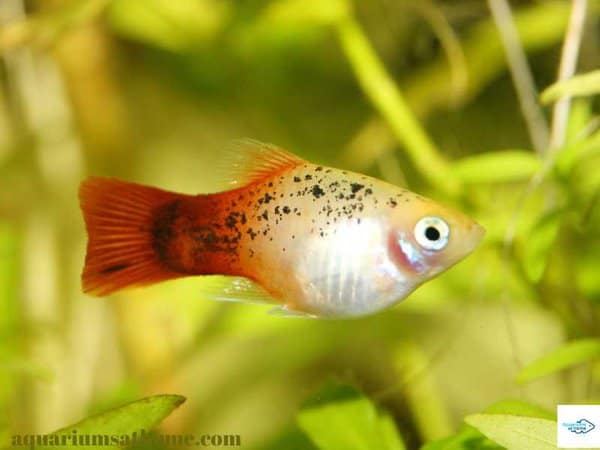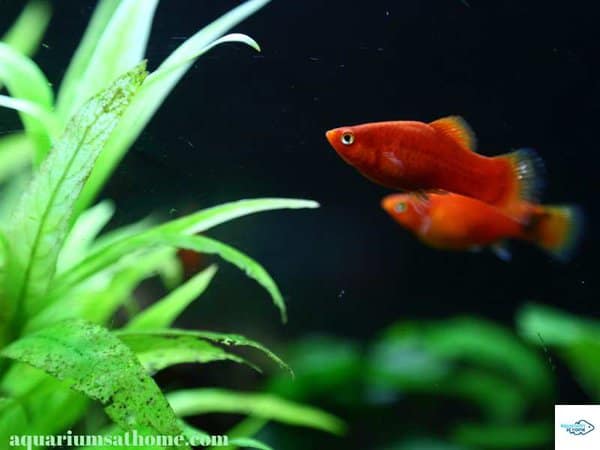When you visit your local fish store, one species you’ll likely see is the platy. Platies are a common and popular choice for fish keepers. What you may not know is there are many different types of platy fish. Knowing the different variations beforehand will help you select the best one for your tank when ready.
The different pattern types for platy fish include the albino, comet, hifin, pintail, rainbow, salt-and-pepper, tuxedo, wagtail, and variegated (painted). Most platies have the same body and fin shape except for the hifin and pintail varieties.
Now that you know there are 9 different pattern types for platy fish, let’s ‘dive deeper’ together and explore this topic further. We’ll learn more about the details of each type, which color or pattern is the rarest, which are more colorful – the males or the females, and how to keep their colors from fading.
So, if you’re ready to discover all you need to know about platy fish and their unique coloration, then let’s get to it!
Color Variations of Platy Fish
Platy fish are highly popular with freshwater aquarists. Derived from the Xiphophorus genus, this species is a type of live-bearing fish that prefers harder water that’s warm, but not tropical water warm. These fish are known for their bright colors and unique patterns, which we’ll discuss in more detail below…
The Albino Pattern
Albino platies look like salt-and-pepper platies but have red around their eyes. They often display black markings on the tail and an iridescent shade of white or whitish grey along the head and body. These platies appear to glow-in-the-dark under UV and blue LED light, making them an eye-catching attraction.
The Comet Pattern
Comet or twin-bar platies are a combination of other color patterns ending in a full, vibrant tail with two solid black strips along the top and bottom of the tail fin. Comet platies display primary colors (mostly yellow) with a caudal fin outlined in black. Gold twin bars are very popular with freshwater aquarists.
The Hifin Pattern
Hifin platies display an elongated dorsal fin in a wide range of colors and patterns. The elongated tail, though attractive, makes them more susceptible to both ‘nipping’ and disease. Keepers of this platy must maintain optimal water conditions and monitor the tank closely for signs of bullying or stress.
The Pintail Pattern
Pintail platies are not as common as hifin platies but standout all the same. These fish display a unique elongated tail with a pointed end that juts out, much like that of a pin. Their appearance often has them confused with swordtails which is another type of small freshwater fish within the same genus.
The Rainbow Pattern
Rainbow platies are multi-colored. They usually display their vibrant hues in true rainbow form – darker colors near the head, gradually getting lighter along the body and finishing with a black tail. A popular iridescent version of this fish is sold under the name of neon rainbow which appears to glow-in-the-dark.

The Salt and Pepper Pattern
Platy fish that are light or pale in color and sprinkled with dark or black spots are of the salt-and-pepper variety. They can exhibit several different base shades which typically range from pastel yellow to muted green. Varying fin and tail markings are also possible with this ‘twist’ on the variegated color pattern.
The Tuxedo Pattern
Platy fish with black markings along the back and any other color in the front are referred to as tuxedos. Red and gold are most common with additional color variations represented in both the comet (red with and black tails) and twin bar pattern (gold with two black stripes on the top and bottom of the tail fin).
The Wagtail Pattern
Platy fish with black caudal and dorsal fins are called wagtails. The body can be any color with a variety of patterns throughout. The most common shades are red and/or gold with blue and green also being displayed. This pattern is characteristic of the swordtail fish which is another species within the genus.
The Variegated Pattern
Platy fish with dark spots of varying color and shape are called variegated or painted since they look like the splotches created by a painter’s brush. These spots can merge with any solid base color and/or tail variation. The Mickey Mouse platy is one such example which showcases a Mickey design near the tail.
*it’s important to note that platy fish come in a variety of colors including red, orange, yellow, green, blue, brown, black, and white. Variations of these colors (in both intensity and arrangement) are present in the different pattern types listed above.
What is the Rarest Platy Color?
The neon gold calico platy is extremely rare. Its head is orange and its body is iridescent gold or yellow with black markings on its lower body and tail. Extreme care and attention are necessary when keeping this type of fish. Warm water (70- to 82-degrees Fahrenheit) and a higher pH (7.0 to 8.5) are required. Their bright colors and fancy tails can also draw unwanted attention from nip-happy tankmates.
Are Male Platies More Colorful than Females?
Typically, when it comes to platy fish, males are more colorful than females. They’re also brighter and more ornate though the patterns on both genders are usually the same. The vivid hues on the males serve to attract the females for procreation purposes but can also attract unwelcome attention from aggressive tankmates.

How to Keep Platy Fish Colors Bright?
To keep your platy fish colors bright, feed them a variety of high-quality flaked, pellet, and freeze-dried foods. As omnivores, these fish need both plant- and meat-based edibles for optimal health. Offer them blanched veggies like lettuce, cucumber, zucchini, and squash along with protein-rich options including live or frozen brine shrimp.
You can also offer them color-enhancing pellet food like these color enhancing food options available on Amazon which are rich in beta-carotenes and help to provide vibrancy. Check out your local fish store or online aquarium retailer for price and purchasing options. Be aware, however, that color-enhancing fish food alone isn’t a staple but rather a supplement.
Final Thoughts
To sum things up, there are 9 different pattern types for platy fish. These include the albino, comet, hifin, pintail, rainbow, salt-and-pepper, tuxedo, wagtail, and variegated (painted). All except two (the hifin and the pintail platy) have the same body and fin shape.
I trust this article has provided the information you seek regarding platy fish and their unique coloration. Thanks for reading. Good luck with your aquarist hobby!
Recommended Posts
What Livebearers can Crossbreed?
Will Mollies and Platies Breed?
25 Most Popular Freshwater Fish for Aquarium
Can a GloFish Live with Normal Fish?






